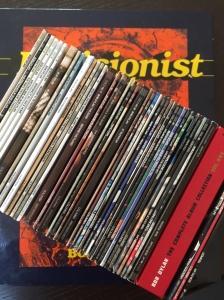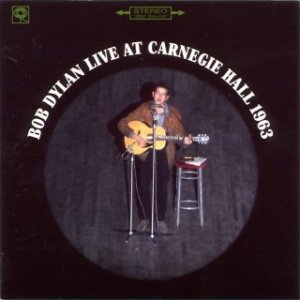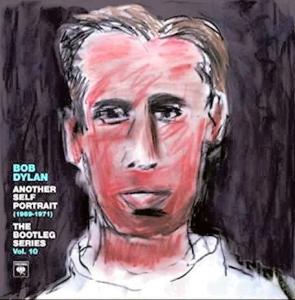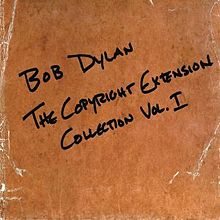Month: December 2014
Fiftieth Anniversary Collection (1963)
StandardOwen Wilson Anecdote
StandardI don’t have anything much to say about this anecdote other than it is just about a perfect late night talk show story told by Owen Wilson about going to Bob Dylan’s house with Woody Harrelson. A great non-story, wonderfully told.
Another Self Portrait
StandardFace Value
StandardWhile it likely won’t be his final art show, the last one that I will be writing about it on this blog is Face Value, an exhibition of a dozen new paintings at the National Portrait Gallery in London. It ran from August 2013 to January of this year. It was pretty okay.
I like the National Portrait Gallery, which is sort of an adjunct to the National Gallery. Like a proper National Gallery, both offer free admission, and since they’re right in the heart of things at Trafalgar Square I always make an effort to stop by when I’m in London. The National Portrait Gallery has the advantage of not being completely swamped with people during tourist season, and they often have good, small shows.
This Dylan show was probably intended to be one of them. It is only twelve paintings, all portraits of course (in keeping with the theme of the museum). They are all the same size (two feet high, a foot and a half wide) and each is pastel on paper. There is a real consistency to them – strong lines, smudged colours, straight address of the sitter to the viewer. Each of the works is titled with the name of the sitter, but none of them were names that I recognized. As drawings I think that they’re better than anything else Dylan has yet shown, though I don’t love them.
The catalogue features an essay and interview with Dylan by John Elderfield. This is the best example of Dylan speaking about his art, so if this is a topic of interest to you it is probably worth checking out the interview. Dylan, as is typical of him, constantly thwarts the questions, rejecting their premises. The most interesting moment is right at the end:
JE: There must be hundreds of individual characters in your songs, yet there is hardly any description of their appearances. Is that why you have wanted to make sketches and paintings of the appearances of characters you have seen?
BD: No, that’s not the reason. I don’t feel that anything is lacking or absent from my songs. I haven’t been waiting fifty years to put “Girl From the North Country” on canvas, as if the song wasn’t enough. The songs don’t inspire me to paint. Painting for me is a secondary occupation. I’m thinking of anything but lyrics when I paint; mine or anybody else’s. If you want to talk about songs we can do that all day. And if you want to talk about paintings we can do that, too. If you see a relationship between the two art forms, that’s up to you, but I certainly don’t. I just did a series of New Orleans-based paintings for the Palazzo Reale in Milan and nobody assumed they had anything to do with the songs I’ve written. There’s a simple reason for that: there is no connection. I know there are some people uncomfortable with that idea, but that has nothing to do with me. That’s them thinking that they’re thinking.
So there you go.
Also, the catalogue has a great photo of Dylan from the 1990s in his painting studio with one of dogs. He’s wearing Zubaz and a tank top that says “Italia Roma”. It’s awesome.
Kohl’s Ad
StandardContinuing the march of Bob Dylan songs in television ads, I give you this rather maudlin entry from the folks at Kohl’s. We don’t have Kohl’s here, so I actually had to look up the fact that they are a department store. Apparently they specialize in sappy niceness. Here you go:
This is not a good version of “Forever Young” and it’s not really even a very good ad. As Dylan ads go, this one has very little to recommend it.
“Like a Rolling Stone” (Video)
StandardI know what you’re saying: Sure, you’ve written about Bob Dylan for fifty-one weeks and got me all the way up to 2013, but how have you really improved my life? Other than watching that Dennis Hopper movie so that I didn’t have to?
Well, here’s how: I watched the “Like a Rolling Stone” music video sixteen times in a row this afternoon. You’re welcome.
So, as a way of promoting the release of the Complete Album Collection, Bob Dylan opted to create a music video for “Like a Rolling Stone” forty-eight years after it was released. That is, to say the least, risky. Let’s say that Rolling Stone magazine has already called your song the best rock song ever written. You now have no where to go with it but down. So you’re going to make a video for that song? Really?? Are you sure you want to do this? Because it needs to be epic. EPIC. Best music video of all time kind of thing. Are you sure? Ok, let’s go.
Dylan, who made a lot of really poor videos in the 1980s and 1990s, but whose videos have come on strong thanks to Nash Edgerton, turned to Vania Heymann. I hear you saying “Who?”. Yep, Vania Heymann. Charged with making a video for the Greatest Rock Song of ALL TIME ™ Dylan and Sony chose a young Israeli filmmaker who’d done about five videos and some tv ads. Umm, what?
And what did he do? Well, he might have created the greatest music video of all time. If it’s not, it belongs in the conversation.
Here’s what they did. They recorded, over a period of two and a half months, sixteen different music videos for the song. Sixteen! Each and every one of which is meant to look like a different genre of American television programming. Then they combined them all together and made it so that you could change the channels like you’re watching tv but that all of the channels are playing “Like a Rolling Stone” now and forever. It is, in a word, awesome. Seriously, it’s just the best thing ever.
I watched this video when it came out – it got a lot of press, and you couldn’t miss it. But I didn’t really watch it watch it. I didn’t flip through and try to imagine what might be the best possible way to watch it. Each airing of the video ends with the same opening and a seemingly random channel is given to you (I’m not sure how random – I got most of the channels in the 120s twice, but never got some in the 130s. I only watched it sixteen or seventeen times though). You can then flip however you want. As you do you will note that every person on screen is lipsyncing the song.
The appeal of the video is that you can’t take it all in – you’re always going to miss something. Unless you tune to one channel and leave it there. It is possible to pause the video immediately after the opening, tune to the channel you want, and then watch the whole thing, all 6:13 of it.
So, of course, that’s what I spent the afternoon doing. 96 minutes of “Like a Rolling Stone” over and over and over and over again. So here’s what’s on every channel – graded.

121 Mus1c Classics. This channel shows a live version of Dylan and The Hawks playing “Like a Rolling Stone” in England in 1966. The video is in color and jumps around a bit, but is otherwise pretty great. This one is a B+. If this had been the video for this song it would have made sense, but it would have got no attention at all.
122 Mus1c Bass. This is a more contemporary video starring rap star Danny Brown. He eats a lot. That’s pretty much the video. Danny Brown walking around New York eating Chinese food, and pizza, and a hot dog, and pop corn. He plays on the swings, and there is some low level animation that pops up the lyrics and the pizza cheese oozes all over the place. I like the swish cuts to different version of Brown. It’s pretty good. B
123 Shop TV: Dustbuster. This is a home shopping channel demonstration of a dustbuster. It looks like a good dustbuster, but that’s all there is here. No real jokes or anything. It is immensely accurate to the lighting and pacing of the home shopping channel, which is what it wants to be. But you shouldn’t watch it. D for entertainment, A for accuracy.
124 History Channel: “Inside the Great Depression”. This starts sort of like “Dustbuster” – it’s just a very good impression of the genre, with three talking head experts (two men, one woman), interspersed with footage of New York from days of yore. Here’s the thing though – new footage has been inserted into the old footage. A newspaper barker barks the lyrics. Two guys hang out a window lipsyncing. Best of all, a sign in Times Square says “Make a Deal”. It is the alteration of this historical material that makes this – it’s very subtle. A+. This is the best channel.
125 Moviez: “Love is Love”. This is really well done, but you shouldn’t stick with it. This is a parody of a contemporary romantic comedy with a young, white couple hanging out on the steps of an upper west side apartment. They talk. They kiss. She walks away. She comes back. They walk in almost slow motion. They go to a diner. Never have two people smiled at each other for this length of time. It is uncanny in its send-up of rom-com tropes, but there isn’t much happening here. It’s too much. C. Small doses only!
126 TTC: “Bachelor’s Roses”. I’ve never seen The Bachelor, but I think that this is probably eerily accurate. Three women in improbable outfits sit around gossiping. A fourth appears on a balcony. Yelling ensues. The fourth at one point goes and gets an outfit and throws it down the stairs. Drama! For the last verse it shifts to the bachelor in a hot tub with Lesley, a paralegal from Duluth. They sip champagne and laugh. Bonus points for “paralegal from Duluth”. This one is watchable. B+
127 MTC Business: “Wall Street Market Update”. This would be boring – it just tosses from a guy in the studio to a woman reporter on Wall Street – were it not for the scroll at the bottom. The first clue that something is going on is the headline: “Some stocks went up and some stocks went down”. From there it is just a litany of ironic one-off jokes:
- Banks still dealing in imaginary money
- Just in: Police still occasionally killing some hooded teens
- Richest 1% controls 33% of wealth
- Small minority exploiting democracy as a means of establishing themselves as a superclass #conspiracytheory
-
Greece to default on everything, just an overall default
-
Breaking: The wealthiest country on Earth boasts some of the largest rich-poor divides #guesswho
- West: “I throw these Maybach keys, I wear my heart on the sleeve, I know that we the new slaves, I see the blood on the leaves”
A Bob Dylan video that quotes Kanye West’s “New Slaves” as part of a business parody? The best. A+
128 Cuisine “Childhood Flavors”. With your host, Suzy Altman. This is what it looks like. This woman makes desert. She chops berries, puts them in a bowl. Adds sugar and starch, mixes. Makes some dough, mixes that that. Puts the berries in the bowl, plops on some dough and puts it in the over. The timer speeds up, then she takes it out and eats it. Delicious! But you don’t need to watch this (though I think the recipe is probably accurate). D
129 Reality Check: “Pawn Stars”. This should have been better than it is. After Dylan appeared on Pawn Stars, the stars of that show appeared in his video. Rick and Chumlee negotiate with a seller named Michael over a Stauffer guitar. Scarily accurate to the aesthetic of the show, but kind of pointless. I would have liked them to indicate that there was no sale here. D+
130 Look TV: “Fasion In and Out”. Of all the fake channels, this one has the best logo. Love that logo. This goes back and forth between a woman talking about a runway show (based on a tennis theme – all the clothes are white and the walkway is a faux tennis court) and then the same woman conducting woman on the street interviews. This might be accurate – I never watch this kind of show! In the middle is an ad for “Girl Code”, which I though was hilarious until I learned that it is an actual show on MTV. Who knew? Not me. I want to watch it. C-
131 GSC: “The Price is Right”. This works in small doses. They use the actual set and the actual host (Drew Carey), but they don’t do a whole episode. They jump around too much – introducing the prize, but then moving to the big wheel. I would have liked this better if they had been faithful to the actual show. I am a nerd. B-
132 WTFC: “Maron”. This didn’t work for me. Marc Maron is a podcaster and here he is podcasting. He gets 99% of the lyrics but there is nothing happening in this video. Skip. F
133 SportsTime: “Pan-Asia Tennis Tournament”. This was filmed in Israel apparently. And Steve Levy, the in-studio host, is a real ESPN guy also. This should have been better. The problem with filming a fake tennis match (between the 117th and 226th ranked men’s players, which is funny) is that you reduce the lipsyncing. There is a lot of cutting back to the studio and Levy, but that breaks the verisimilitude since that is not how tennis is covered. The best part is the crowd member yelling “Ahhhh” and pointing at the net at the beginning of the final verse. D
134 Home+ “Property Brothers”. Like Pawn Stars and The Price is Right, this is a real show (Canadian too!), starring the hunky Jonathan Scott and his hunky brother Drew. They sell people fixer uppers and then fix ’em up. They have the aesthetic of this show nailed (ahem), but there’s not much plot here. B-
135 Just for Kids! “Zoey and Socks”. I’m guessing that the girl is Zoey and that the floating cat is Socks. Just a guess though. There are also Murakami-esque smiling flowers. And word games. All the words are missing one letter indicating that the show is for two or three-year-olds, but the words are sometimes odd: ME_APHONE. Hard to pay attention to this one. The still sums up all the action, though later Zoey and Socks move to the clouds just to mix it up (or the flowers pissed them off). D
136 BCC Newsdesk. Looks more like BBC than CNN, which is probably the Israeli influence. The scroll here isn’t meant to be as funny – the image above notwithstanding – and mostly is played semi-straight (a lot of stuff about Obamacare). They go through several stories each lasting roughly a verse and chorus:
- Airport Nightmare
- Riots on Park Avenue
- Man Stabbed in Chelsea
- Weather
The best of these is the stabbing. Here they use faux surveillance footage, and the stabbed man slumps into a corner and then starts singing “Like a Rolling Stone”. I suppose he was stabbed by the mystery tramp. A
In an interview Heymann said: “The effect can only be surrealistic if the channels are realistic. In reality, channel-flipping is a very passive act. You’re sitting back in your house, doing nothing. We wanted to make it an active thing, reediting the song itself to make a new version.”
Well, it works. I think it is the most interesting music video I’ve ever seen. It was named best video of 2013 by Time, but MTV shunned it – it wasn’t even nominated for a music video award. Best video, for the record, went to Miley Cyrus for “Wrecking Ball”. Yes, Miley licks a sledgehammer and rides a wrecking ball in the nude, but there is nothing interesting in that video at all that you can’t get better on any of a thousand free porn sites. Ohh, MTV, are you really that hard up? Miley spawned a million memes, but Dylan and Heymann legitimately broke new ground. Again.
Oh yeah: Here’s the video! (I don’t think WordPress can embed it, probably requires Java)
50th Anniversary Collection
StandardTempest
StandardRevisionist Art
StandardMG: Before we end the conversation, I want to ask about the controversy over your quotations in your songs from the works of other writers, such as Japanese author Junichi Saga’s “Confessions of a Yakuza,” and the Civil War poetry of Henry Timrod. Some critics say that you didn ‘t cite your sources clearly. Yet in folk and jazz, quotation is a rich and enriching tradition. What’s your response to those kinds of charges?BD: Oh, yeah, in folk and jazz, quotation is a rich and enriching tradition. That certainly is true. It’s true for everybody, but me. I mean, everyone else can do it but not me. There are different rules for me. And as far as Henry Timrod is concerned, have you even heard of him? Who’s been reading him lately? And who’s pushed him to the forefront? Who’s been making you read him? And ask his descendants what they think of the hoopla. And if you think it’s so easy to quote him and it can help your work, do it yourself and see how far you can get. Wussies and pussies complain about that stuff. It’s an old thing – it’s part of the tradition. It goes way back. These are the same people that tried to pin the name Judas on me. Judas, the most hated name in human history! If you think you’ve been called a bad name, try to work your way out from under that. Yeah, and for what? For playing an electric guitar? As if that is in some kind of way equitable to betraying our Lord and delivering him up to be crucified. All those evil motherfuckers can rot in hell.





























